What Is a Content Audit?
A content audit is a methodical examination and assessment of the content elements and information assets present on a website. This procedure includes a thorough evaluation of all the content, encompassing blog posts, landing pages, and other materials. The primary purpose of a content audit is to make informed decisions about how to manage existing content, whether to update, retain, consolidate, delete, or create new material.
Why Are Content Audits Important?
Understanding the significance of content audits is crucial for improving your website’s performance and achieving your business goals. Effective SEO techniques employed during a content audit not only improve your site’s reach but also provide insights into optimization opportunities. By pinpointing supportive elements, such as broken links, you not only boost SEO but also enhance the overall user experience.
Content audits play a pivotal role in content strategy, allowing you to evaluate and organize your existing content effectively. This process provides clarity for future content marketing strategies, helping you plan and create additional content that aligns with your objectives.
Key benefits of content audits include:
- Performance Evaluation: Gain valuable insights into how your content is performing by analyzing metrics such as page views, bounce rates, and conversion rates.
- Gap Identification: Identify gaps in your content offering, ensuring that your website addresses the full spectrum of information your audience seeks.
- Informed Decision-Making: Make informed decisions on how to enhance your content based on performance data, improving its relevance and effectiveness.
Additionally, content audits help you identify and eliminate duplicate or outdated content. This not only streamlines your website but also contributes to improved SEO performance. In summary, a thorough content audit is a foundational step toward optimizing your online presence, refining your content strategy, and ultimately achieving your business objectives.
Now that you have an understanding of what content audits are and how important they are, let’s explore the various areas you need to analyze when conducting content audits.
Content Decay
What is content decay?
Content decay refers to the ongoing decline in organic traffic and rankings for a specific page or multiple pages over time. The term ‘decay’ emphasizes the gradual nature of this decline compared to a sudden drop.
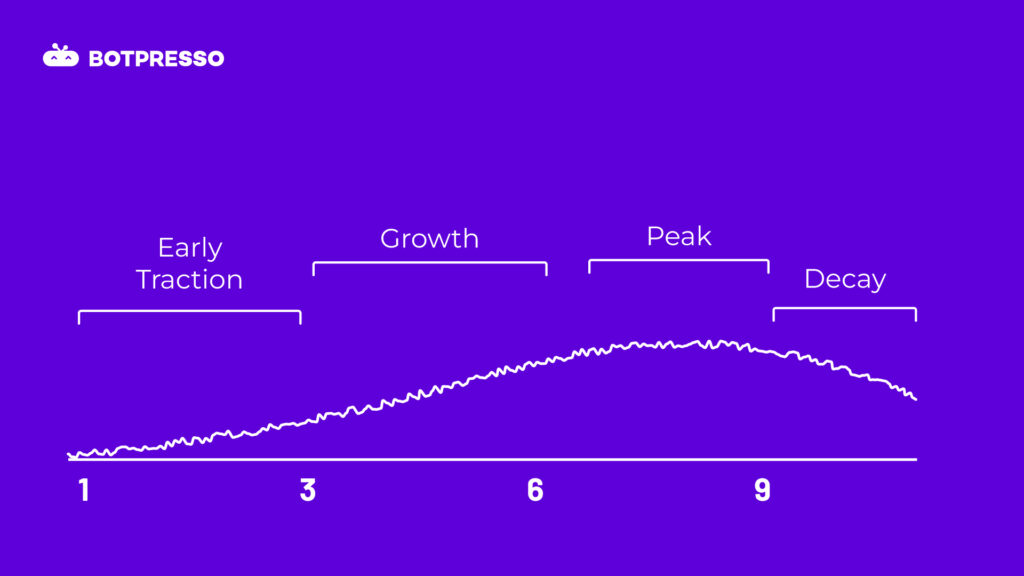
What causes content decay?
Content decay occurs due to various factors, including the need for freshness, internal competition within a website, external competition from new content creators, shifts in search intent, and the importance of maintaining topical depth. To combat decay, it’s crucial to regularly update content, manage internal competition through strategic linking, stay aware of industry trends, align with current search intent, and ensure content depth to meet evolving user expectations.
How to audit content for decay?
Ensure your content remains fresh and relevant by regularly assessing its timeliness, accuracy, and usefulness for improved SEO rankings and sustained traffic. Follow the below steps to identify these areas:
Step 1: Setup and Data Extraction
To conduct an effective content decay audit, begin by exporting data using Search Analytics for Sheets—an add-on seamlessly integrated with Google Sheets. This tool facilitates the retrieval of queries, pages, clicks, and other necessary data directly from Google Search Console for any of your verified websites.
In the sidebar, select the verified GSC property for which you wish to gain insights. For a thorough analysis, export data for the past 12-16 months to observe trends over time. Ensure that the data is exported month over month (m-o-m) instead of as a cumulative figure for the specified period. Choose “Default (Web)” as the Search Type, and under “Group By,” select “Page” as the attributes. Set filters based on your objectives, such as excluding branded queries or focusing on specific geographic regions, and hit Request Data once all set!
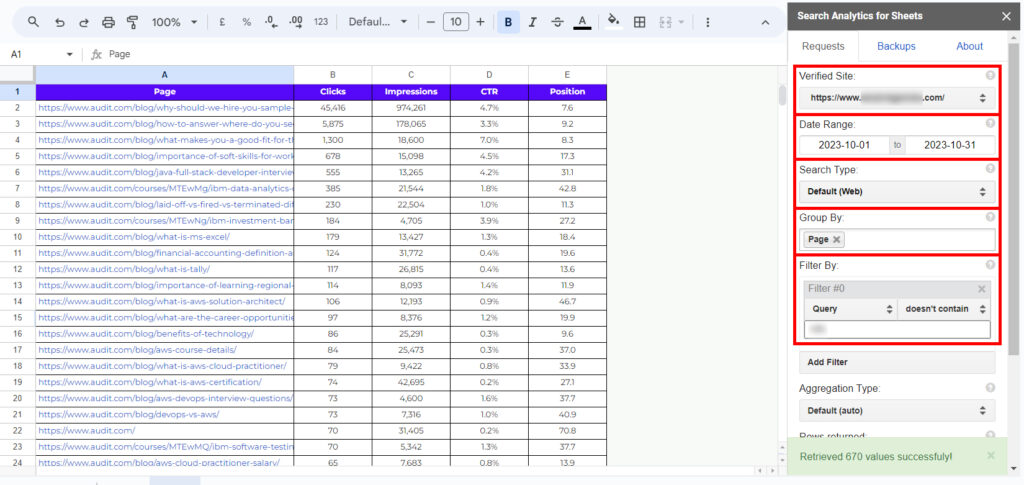
Note: The process of data extraction m-o-m can be a tedious task as it would take a lot of effort to download and organize data for 12-16 months
Step 2: Data Organization
Arrange the extracted data systematically to provide a (m-o-m) overview, offering a holistic perspective on each page’s performance.
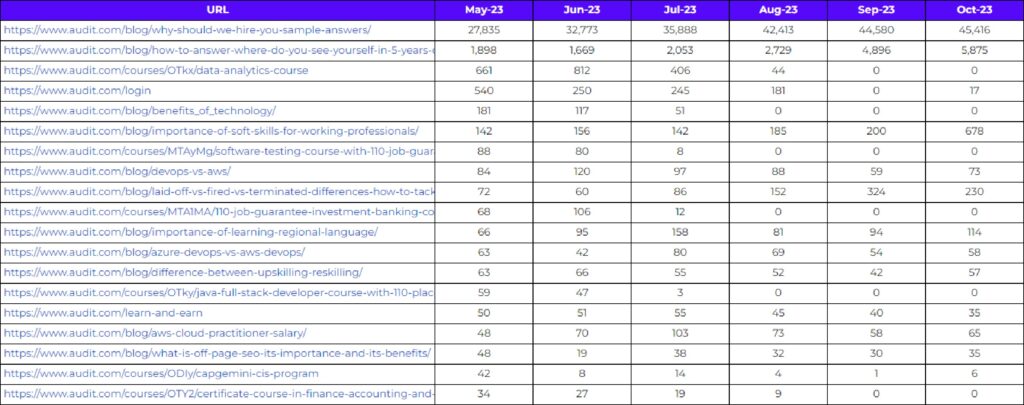
Step 3: Conditional Formatting for Visualization
Enhance the visual analysis by implementing conditional formatting where we select the entire column and add a rule as shown below. This will help highlight the cell if there is a drop as compared to the previous month. This approach provides a bird’s-eye view of click trends, indicating declines and spotting decay or trends at a glance.
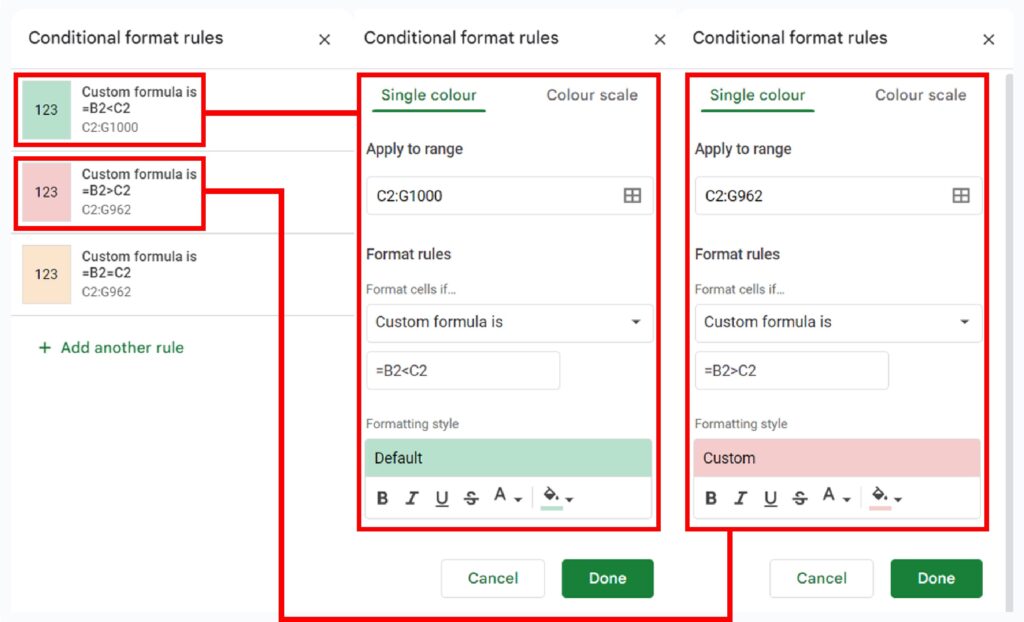
Step 4: Analyzing Click Drop Numbers from the Peak Month
Supplement your analysis by adding a column comparing the highest achieved traffic with the traffic acquired for the most recent month. This comparison helps identify pages requiring content optimization efforts. Identify pages with a sustained decline, creating a shortlist for re-optimization or necessary enhancements to revive their performance. To get the Highest Click I have used =MAX(C2:G2). This formula returns the highest value in the range C2 to G2, and =MIN(D2:H2) returns the lowest value in the range C2 to G2. You can use this to get an estimate of the lowest traffic achieved.

Once you have the Highest Clicks, subtract the number from the Clicks received for the most recent month. This will help you get a better picture of the highest potential for that particular URL
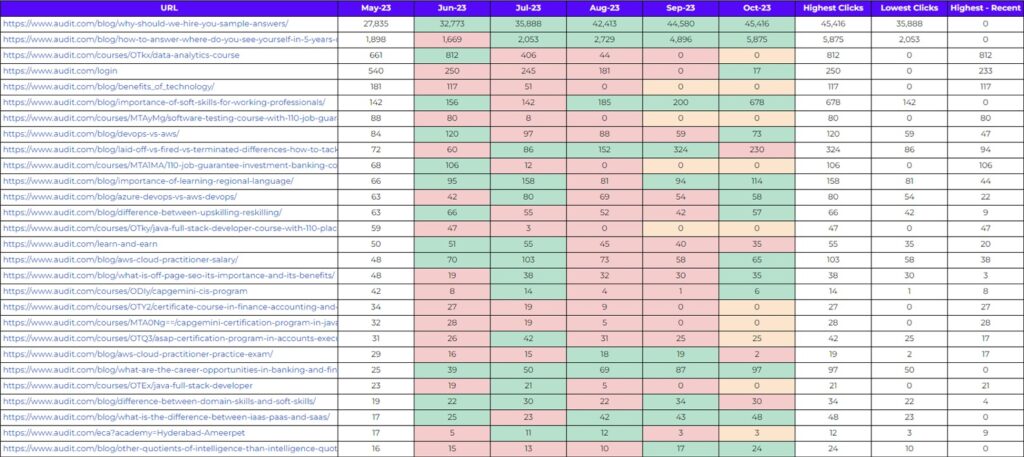
You can also conduct the content decay by connecting Google Data Studio to Google Search Console.
Keyword Cannibalization
What is keyword cannibalization?
Keyword cannibalization occurs when multiple pages on a website are set up to potentially compete for the same search query on Google, either due to their closely related topics or because they have been optimized for the same query.
When posts or articles compete for similar search queries, they undermine each other’s chances of ranking. Typically, Google tends to display only 1 or 2 results from the same domain in search results for a specific query, although high-authority domains might get up to 3.
What causes keyword cannibalization?
Keyword cannibalization occurs when identical or similar queries are scattered throughout the content on a website. This confusion makes it challenging for search engines, like Google, to determine which content to prioritize, leading to unintended higher rankings for certain pages.
How to audit content for keyword cannibalization?
Optimize your content strategy by identifying and resolving instances where multiple pages competing for the same keywords, preventing cannibalization and enhancing search engine rankings and traffic distribution. Follow the below steps to get started:
Step 1: Setup and Data Extraction
Here again, we start by connecting Google Spreadsheet with the Search Analytics for Sheets Add-on. Once synced, choose the verified Google Search Console (GSC) property for which you want to extract data. Set the desired date range, select “web” in the search type, and add “query” and “page” as attributes in the group by section. Hit “Request Data” after setting all the necessary filters. Do not forget to exclude branded queries from the list!
Step 2: Data Organisation
Depending on the website’s size, data extraction may take some time. Once the data is obtained, organize it by selecting the entire “Query,” “Page,” and “Clicks” columns, and insert a Pivot table. Initially, identify queries with cannibalization issues by adding “Query” under the Rows section and “Clicks” & “Pages” under Values. Summarize clicks by SUM and pages by COUNT. This provides a count of URLs associated with a particular query and the sum of clicks attributed to that query.
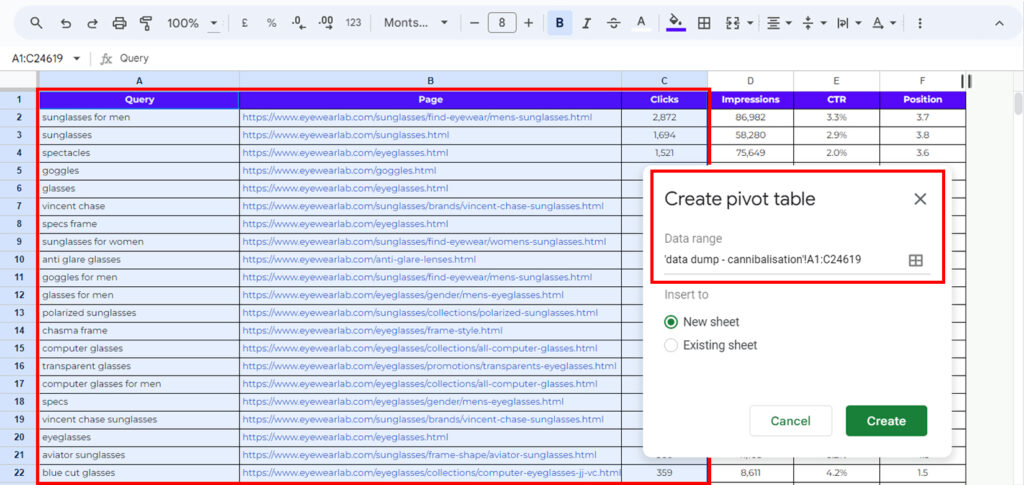
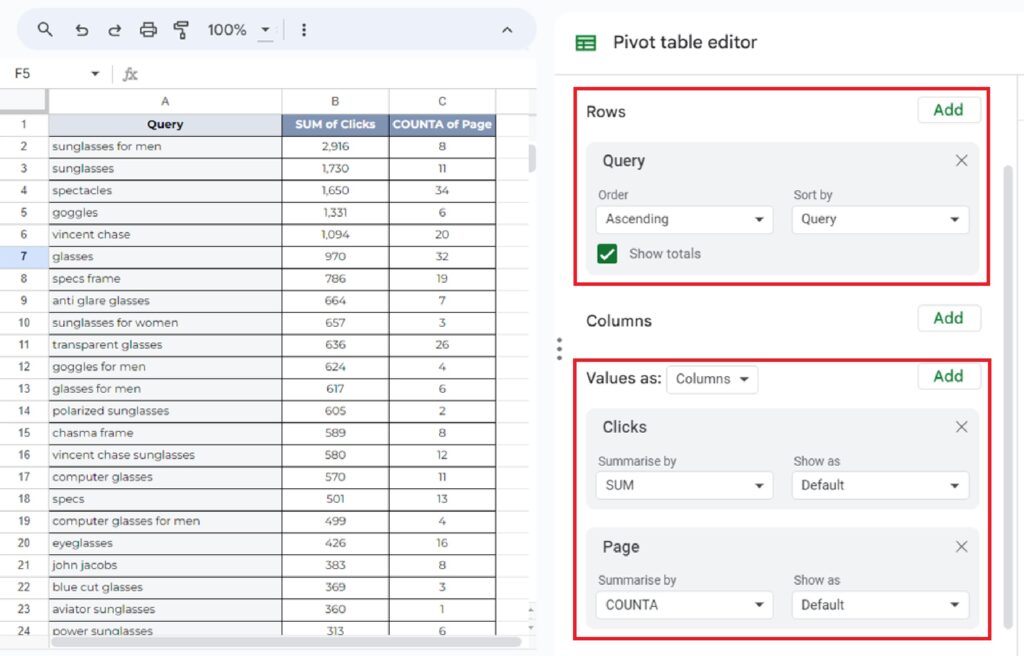
Step 3: Strategize and Way Forward
Based on the data, prioritize and strategize the top queries that need fixing. Consider factors like total clicks or the count of total URLs. Once the top queries are finalized, identify the pages causing cannibalization by going back to the Pivot table. Follow the same steps, adding “Page” under the Rows tab.
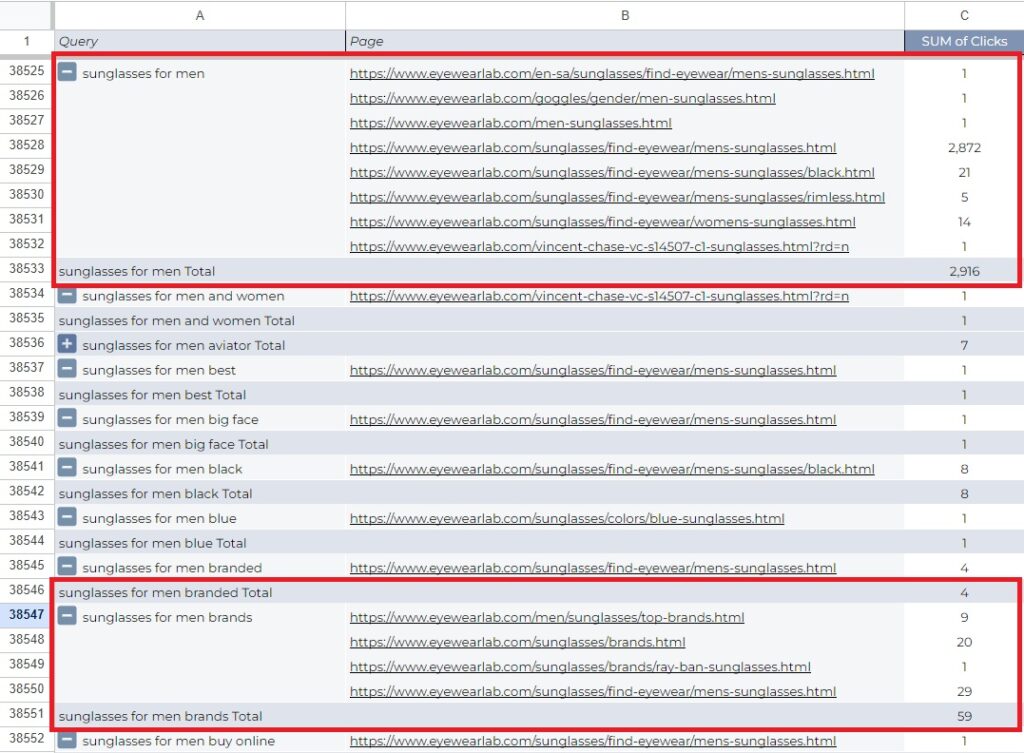
This focused approach helps avoid cluttered data and allows for the application of filters to prioritize datasets. After identifying the queries and relevant URLs causing cannibalization, optimize them accordingly.
It is essential to recognize that while a content audit is a common practice for most websites, the approach may vary depending on the niche and the nature of the business. For example, websites offering Software as a Service (SaaS) may present unique opportunities. You can explore my guide on Content Strategy for SaaS to uncover valuable insights.
Zombie Pages
What are zombie pages?
Zombie pages refer to web pages that generate minimal or no organic traffic. Although they may be indexed and attract visits from search engine crawlers, they fail to engage real visitors. Essentially lifeless, these pages often suffer from poor search rankings, making them a wasted space for search engines.
How to identify zombie pages?
Before deciding to revive or retire zombie pages, it’s crucial to identify them. I recommend using Google Search Console to identify these areas of improvement.
If you’ve been working on content for a while, you likely have content falling into the following categories:
- Consider either re-optimizing/updating pages to align with search intent
- Merging them with similar content
- Deleting and redirecting them to a more prominent page
How to audit content for zombie pages?
Eliminate or optimize irrelevant or underperforming pages from your website to prevent them from negatively impacting SEO, ensuring a streamlined content structure that enhances rankings and attracts valuable traffic by following the below steps:
Step 1: Setup and Data Extraction
Assuming familiarity with using Search Analytics for Sheets with Spreadsheet as mentioned above let us proceed to set the date range for the past 12 to 16 months, select “web” in the search type, add “page” as an attribute in the group by section, and click on “Request Data.”
Step 2: Filtering and Organizing Data
Begin by applying a filter for pages with less than 10 clicks. Pages receiving less than 10 clicks in the past 12 to 16 months need analysis. Exclude articles less than 2 to 3 months old. Focus on older pages for scrutiny.
For pages with low clicks but high impressions, start by examining the type of queries they are gaining impressions from. Assess if the queries match the page’s intent and relevance. If so, reoptimize the content on the specific pages for those queries. If queries are already targeted, explore areas like meta tags, content gap vs. top-ranking SERP competitors, internal links, etc.
If the queries seem irrelevant, check SERPs to understand the intent and decide whether to create a new page. Pages with minimal impressions and clicks can be merged with similar content pages, enhancing existing content quality. Pages with no impressions or clicks should be deleted and redirected to a page covering a similar topic.
You might be familiar with the notion of creating content for zero-search-volume queries, a concept that is sometimes misunderstood. This strategy involves exploring opportunities that extend beyond the data recorded by keyword research tools such as Ahrefs, SemRush, and so on. Pages without traction may be overlooked by Google, underscoring the significance of providing value to users. Delve into my article on zero search volume keywords for a deeper understanding of unexplored possibilities.
Content Clusters
What are content clusters?
Content clusters form a strategic SEO approach aimed at optimizing a website’s structure and internal linking. This involves organizing content around specific topics and utilizing pillar and cluster pages. The concept revolves around employing various levels of web pages to meticulously structure content based on its relevance to specific topics. In essence, a content cluster is a cohesive group of interlinked web pages, collectively centered around a particular theme.
Why build content clusters?
One of the often-overlooked SEO techniques involves tracking and leveraging untapped keywords or low hanging fruit keywords within your existing blog articles. Content clusters play a vital role in demonstrating to Google that your site is an authoritative source within a particular domain. This recognition subsequently contributes to higher rankings in the Search Engine Results Pages (SERP). By focusing on sub-topics related to your site’s expertise, you significantly increase the likelihood of ranking well for corresponding terms, leveraging the authority established by Google.
How to audit content to find cluster opportunities?
Step 1: Setup and Data Extraction
To identify potential cluster opportunities, begin by selecting a specific page or blog URL that you aim to enhance through content clusters or discover untapped keywords. Once you’ve identified the URL, synchronize Search Analytics for Sheets with Spreadsheet, following the instructions mentioned above. Set the date range for the past three months, choose “web” as the search type, and add “query” and “page” as attributes in the group by section. Further, in the “filter by” section, include the identified page or blog URL by selecting ‘page’ and choosing ‘equals to’ from the dropdown menu. Finally, click on “request data” to initiate the process.
Step 2: Filtering and Organizing Data
You now possess a list of ‘queries’, that people searched for, which Google has associated with your article. These queries indicate that individuals searching for these specific terms are directed to your target page in the SERP. Within this dataset, various queries may emerge for which you haven’t crafted an article, despite your website accumulating impressions.
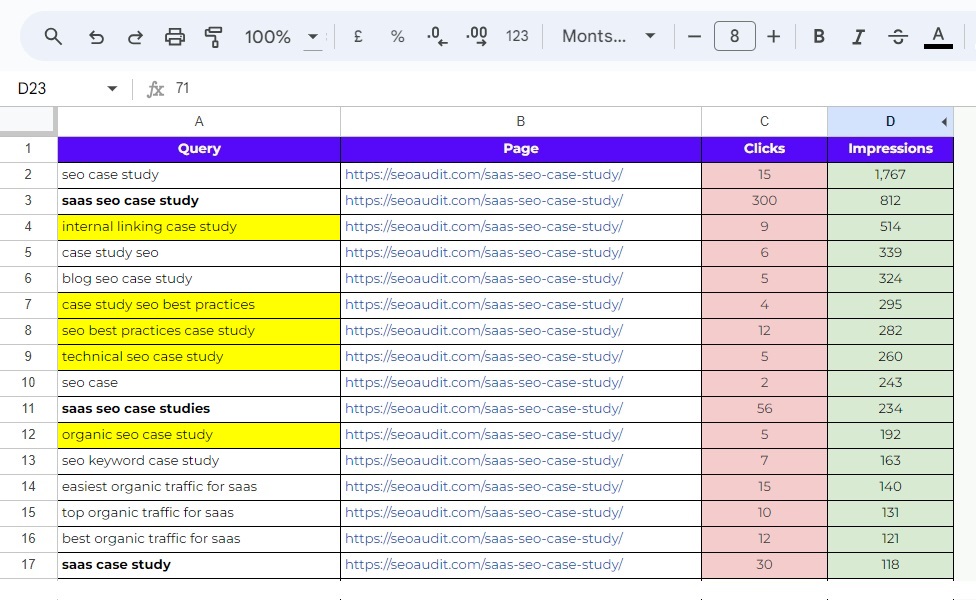
The ones highlighted in yellow are some interesting opportunities to build content around. Now since the article I have selected is related to a case study I need to have sufficient data to back my content but if you are looking to find opportunities around blog topics it should not be that difficult
Step 3: Strategize & Way Forward
Use these queries or topics as the base to conduct additional keyword research. These identified keywords function as valuable assets for generating new articles centered around the specific URL added as a filter. This contribution leads to a more comprehensive and strategically optimized content portfolio, thereby aiding in the creation of content clusters and enhancing your topical authority.
Additional insights to keep in mind!
In the journey of content optimization, consider these key factors for a comprehensive strategy:
Prioritize Your Actions:
Evaluate and prioritize your actions based on the effort required to achieve your business goals. Ensure that every content investment aligns with and supports specific business objectives.
Meta Tags Matter:
Don’t overlook the potential of low-hanging fruits, especially when it comes to Meta tags. Optimize these tags strategically to enhance visibility and relevance in search engine results.
Heading Tags Harmony:
Structure your Heading Tags thoughtfully and in a proper flow. Well-organized headings contribute to a better user experience and improved search engine understanding.
Internal Linking Mastery:
Craft an internal linking structure that seamlessly supports your content. Internal links play a crucial role in building topical authority and guiding users through your website.
Embrace Interactive Elements:
Expand beyond traditional content optimization by incorporating interactive elements. Consider integrating images, videos, and infographics to enhance user engagement and diversify your content strategy.
Word Count Wisdom:
While the debate on word count continues, assessing competitor content and ensuring comprehensive coverage can lead to a potential boost. Strive for a balance between depth of content and audience preferences, aiming for a thorough exploration of relevant topics.
In summary, the success of content optimization lies in a strategic and holistic approach. By addressing these nuanced aspects, you not only enhance your content’s visibility but also contribute significantly to your overarching business goals.
SEO Mastery in Content Audits
In conclusion, mastering website content audits is crucial for optimizing your online presence and boosting SEO without extra costs. The guide covers the significance of content audits, addressing content decay, keyword cannibalization, identifying zombie pages, and leveraging content clusters for SEO. The step-by-step instructions offer practical insights, helping improve website performance, and search rankings, and attract valuable traffic. Additional tips, like prioritizing actions, optimizing meta tags, and considering word count, contribute to a holistic content optimization strategy.
In case you are running low on resources, no need to stress – we’ve got you covered. Content marketing involves a multitude of tasks, and we understand that managing existing content alongside your regular schedule can be overwhelming. Fortunately, at Botpresso, we specialize in content audit, strategy, and optimization. If you’re dealing with the challenge of combating content decay and revitalizing your stagnant content, don’t hesitate to reach out – we’re here to assist! Feel free to ask for guidance, and we’ll be more than happy to help.
Want more golden nuggets of SEO wisdom? Don’t miss out! Follow me on Linkedin and Twitter for exclusive insights, tips, and real-time updates!






